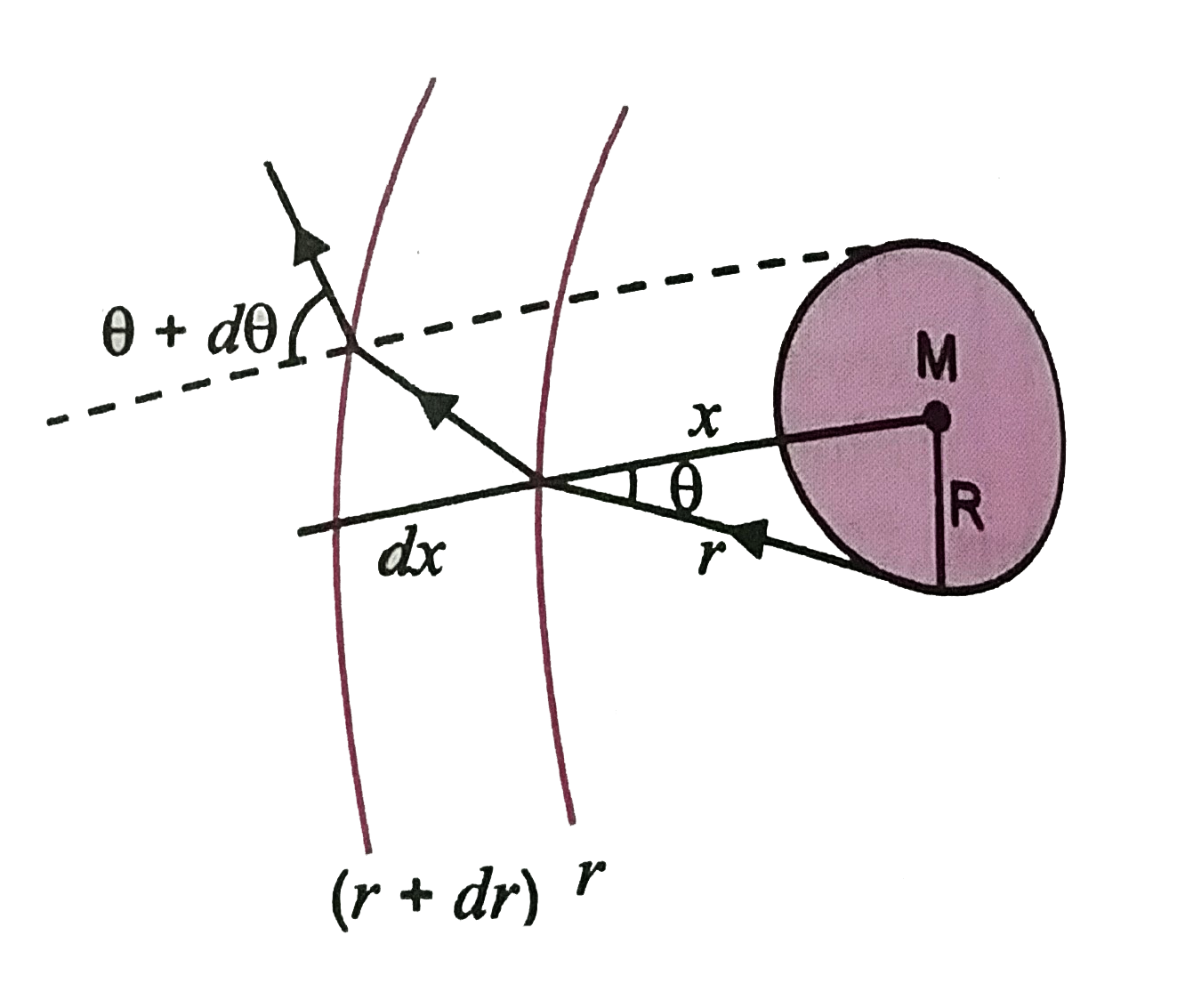If light passes near a massive object, the gravitational interaction causes a bending of the ray. This can be thought of as happening due to a change in the effective refractive index of the medium given by n(r)=1+2GM/rc2
where r is the distance of the point consideration from the centre of the mass of the massive body, G is the universal gravitational constant, M the mass of the body and c the speed of light in vacuum. Considering a spherical object, find the deviation of the ray from the original path as it grazes the object.
In Fig., we have shown a spherical massive body of mass M and radius R. Consider two planes one at r and other at (r+dr) from the centre of massive body. Let the light rays be incident at an angle θ on the plane at r and leave the plane at (r+dr) at an angle (θ+dθ).
According to Snell's law,
n(r)sinθ=n(r+dr)sin(θ+dθ)=[n(r)+dndrdr](sinθcosdθ+cosθsindθ)
As dθ is small, cosdθ≅1andsindθ≅dθ
Neglecting products of differentials, we get
n(r)sinθ=n(r)sinθ+n(r)cosθdθ+dndrdrsinθ or −dndrdrsinθ=n(r)cosθdθ
or −dndrtanθ=n(r)dθdr
As n(r)=1+2GMrc2∴dndr=−2GMr2c2
Put in (i) 2GMr2c2tanθ=(1+2GMrc2)dθdr≅dθdr (∵2GMrc2<<1)
dθ=2GMc2tanθr2dr
Intergrating both sides, we get
∫θ00dθ=2GMc2∫+∞−∞tanθdrr2=2GMc2∫+∞−∞tanθrdrr3
Now, from (Fig. 11(EP).16), r2=x2+R2 and tanθ=Rx
∴2rdr=2xdx∴∫θ00dθ=2GMc2∫+∞−∞Rxdxx(x2+R2)3/2
If we put x=Rtanϕ so that dx=Rsec2ϕdϕ,
then ∫θ00dθ=2GMc2∫π/2−π/2R2sec2ϕdϕR3sec3ϕ
θ0=2GMRc2∫π/2−π/2cosϕdϕ=4GMRc2
This is the deviation for the ray from the original path as it grazes the massive body.
 .
.
Topper's Solved these Questions
- RAY OPTICSBOOK - PRADEEPCHAPTER - RAY OPTICSEXERCISE - (NCERT)Exercise With Solution
38 Videos
- RAY OPTICSBOOK - PRADEEPCHAPTER - RAY OPTICSEXERCISE - Higher Thinking Order
5 Videos
- RAY OPTICSBOOK - PRADEEPCHAPTER - RAY OPTICSEXERCISE - Long Answer (d)
6 Videos
- PROPERTIES OF BULK MATTERBOOK - PRADEEPCHAPTER - PROPERTIES OF BULK MATTEREXERCISE - Multiple choice questions
7 Videos
- SYSTEMS OF PARTICLES AND ROTATIONAL MOTIONBOOK - PRADEEPCHAPTER - SYSTEMS OF PARTICLES AND ROTATIONAL MOTIONEXERCISE - Assertion- Reason Type questions
20 Videos
Similar Questions
Knowledge Check
The value of universal gravitational constant 'G' is
A6.67×1011Nm2/Kg2B6.67×10−11Nm2/Kg2C6.67×1018Nm2/Kg2D6.67×10−18Nm2/Kg2The escape velocity of a sphere of mass m is given by (G=Universal gravitational constant,M=Mass of the earth and Re=Radius of the earth)
A√2GMmReB√2GMReC√GMReD√2GMm+ReReThe acceleration due to gravity'g' for objects on or near the surface of earth is related to the universal gravitational constant 'G' as ('M' is the mass of the earth and 'R' is its radius):
AG=g(M)R2Bg=GMR2CM=gGR2DR=gGM2
If E is energy M is mass, J is angular momentum and G is universal gravitational constant ,then dimensions of x=EJ^2/G^2M^5 can be that of
View SolutionIf the energy, E=Gphqcr, where G is the universal gravitational constant, h is the Planck's constant and c is the velocity of light, then the values of p, q and r are, respectively
View SolutionWhen a ray of light passes from air medium to denser medium then the refractive index is
View SolutionP is a point at a distance r from the centre of a spherical shell of mass M and radius a, where r<a. The gravitational potential at P is
View SolutionIf the energy, E=Gphqcr, where G is the universal gravitational constant, h is the Planck's constant and c is the velocity of light, then the values of p are q and r are, respectively
View Solution
